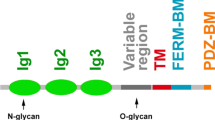12
nerve cells with up to 1015 synapses. In principle, synaptogenesis takes place in two consecutive steps that are most likely mediated by cell adhesion molecules. First, an arriving axonal growth cone identifies its appropriate partner cell, creating an initial contact, and, second, specific axonal and dendritic protein components are recruited to this initial contact site, forming a functional synapse. Three cell adhesion systems have recently been shown to be specifically enriched at synaptic contacts: the cadherin/catenin system, the cadherinlike neuronal receptors, and the β-neurexin/neuroligin system. Components of all three cell adhesion systems have been localized to synaptic contacts using immunogold electron microscopy but are also present outside of synapses. The present short review discusses the possible role of these synaptic cell adhesion molecules in synaptogenesis.
Similar content being viewed by others
Author information
Authors and Affiliations
Rights and permissions
About this article
Cite this article
Brose, N. Synaptic Cell Adhesion Proteins and Synaptogenesis in the Mammalian Central Nervous System. Naturwissenschaften 86, 516–524 (1999). https://doi.org/10.1007/s001140050666
Issue Date:
DOI: https://doi.org/10.1007/s001140050666




